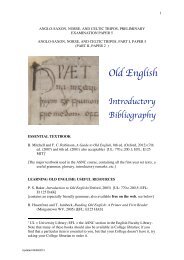Scandinavian history in the Viking age - Department of Anglo-Saxon ...
Scandinavian history in the Viking age - Department of Anglo-Saxon ...
Scandinavian history in the Viking age - Department of Anglo-Saxon ...
Create successful ePaper yourself
Turn your PDF publications into a flip-book with our unique Google optimized e-Paper software.
<strong>Scand<strong>in</strong>avian</strong> History <strong>in</strong> <strong>the</strong> Vik<strong>in</strong>g Age<br />
Poole, ‘Verses and prose <strong>in</strong> Gunnlaugs saga ormstungu’, Sagas <strong>of</strong> <strong>the</strong> Icelanders: a book <strong>of</strong> essays,<br />
Garland reference library <strong>of</strong> <strong>the</strong> humanities 758, ed. J. Tucker (1989), 160-84 [UL 752:37.c.95.34]<br />
[B535] O<strong>the</strong>r m<strong>in</strong>or poets for earl Hakon <strong>in</strong>clude Goþþorm (B510):61-63, Glúm (B510):75-78,<br />
Kormák (B510):79-91, and T<strong>in</strong>d (B510):144-47<br />
Less verse is preserved from <strong>the</strong> court <strong>of</strong> Hakon’s successor Erik:<br />
[B536] Eyjólf dáðaskáld is best known as <strong>the</strong> author <strong>of</strong> Bandadrápa celebrat<strong>in</strong>g many <strong>of</strong> Erik’s battles.<br />
Text: (B510):200-02. Transl. (B515): II,51-52<br />
[B537] Halldór ókristni is known from his Eiríksflokkr. Text: (B510):202-04<br />
[B538] Þórð Kolbe<strong>in</strong>sson was responsible for Eiríksdrápa. Text: (B510):212-19. Transl. (B515): II,102-<br />
05, excerpts transl. (B81):334-35<br />
The poets <strong>of</strong> <strong>the</strong> Christian k<strong>in</strong>gs<br />
Follow<strong>in</strong>g on from <strong>the</strong> verse composed for <strong>the</strong> earls <strong>of</strong> Lade, <strong>the</strong> material from <strong>the</strong> reigns <strong>of</strong> <strong>the</strong> early<br />
Christian k<strong>in</strong>gs naturally reflects (albeit to vary<strong>in</strong>g degrees) a shift <strong>in</strong> religious emphasis; not only did<br />
some poets eschew <strong>the</strong> kenn<strong>in</strong>gs or heiti derived from pagan mythology, but <strong>the</strong>y also employed skaldic<br />
verse to highlight new aspects <strong>of</strong> k<strong>in</strong>gship that entered Scand<strong>in</strong>avia, or were developed <strong>the</strong>re, <strong>in</strong> <strong>the</strong><br />
conversion period. A classic study rema<strong>in</strong>s:<br />
[B540] W. Lange, Studien zur christlichen Dichtung der Nordgermanen 1000-1200, Palaestra 222 (1958)<br />
[UL 779.c.15.142]<br />
For fur<strong>the</strong>r studies on <strong>the</strong> Christianisation <strong>of</strong> skaldic verse:<br />
[B541] E. Mundal, ‘Kristn<strong>in</strong>ga av Noreg og Island reflektert gjennom samtidig skaldedikt<strong>in</strong>g’, CM 3<br />
(1990-92), 145-62 (E.s.)<br />
[B542] B. Fidjestøl, ‘Pagan beliefs and Christian impact: <strong>the</strong> contribution <strong>of</strong> skaldic studies’, (O72):100-<br />
20<br />
[B543] B. Fidjestøl, ‘Skaldic poetry and <strong>the</strong> conversion, with some reflections on literary form as a<br />
source <strong>of</strong> historical <strong>in</strong>formation’, (O10):133-50<br />
[B544] D. Edwards, ‘Christian and pagan references <strong>in</strong> eleventh-century Norse poetry: <strong>the</strong> case <strong>of</strong> Arnórr<br />
jarlaskáld’, SBVS 21 (1982-85), 34-53<br />
[B545] Darraðarljóð is an anonymous poem found only <strong>in</strong> Njáls saga (B411); ostensibly on <strong>the</strong> battle <strong>of</strong><br />
Clontarf, many scholars th<strong>in</strong>k it fits better with a tenth-century date. Text: (B510):419-21. Transl.:<br />
(B593):72-75; (B493):116-56 with discussion<br />
[B546] Sigvat Þórðarson is one <strong>of</strong> <strong>the</strong> most prolific skaldic poets whose work is left to us; he composed<br />
for a series <strong>of</strong> k<strong>in</strong>gs <strong>in</strong> <strong>the</strong> first half <strong>of</strong> <strong>the</strong> eleventh century. Text: Text: (B510):223-75; J. Halldórsson,<br />
Kvæðakver Sighvats Þórðarsonar (1965) [UL 752:2.d.95.1]. The bulk <strong>of</strong> his verse was devoted to sa<strong>in</strong>t<br />
Olaf Haraldsson: [a] The Vík<strong>in</strong>gavísur chart Olaf’s adventures as a young vik<strong>in</strong>g, particularly his<br />
participation <strong>in</strong> <strong>the</strong> raids on England <strong>in</strong> <strong>the</strong> open<strong>in</strong>g decades <strong>of</strong> <strong>the</strong> eleventh century; for text and transl.,<br />
see C. Fell, ‘Vík<strong>in</strong>gavísur’, (O32):106-22, also transl. (B515): II,124-27. [b] Nesjavísur celebrates<br />
Olaf’s consolidation <strong>of</strong> Norway after victory at <strong>the</strong> battle <strong>of</strong> Nesjar around 1016; transl. (B515): II,127-<br />
29. [c] The Austrfararvísur ‘verses on an eastern journey’ relate Sigvat’s adventures on an embassy to<br />
sou<strong>the</strong>rn Sweden. Transl.: (B515): II,129-33; (B516):151-59; (B1):48-54. Commentary: F. Jónsson,<br />
Austrfararvísur, ADNVAO 1931:1 (1932) [UL 500:01.c.13.2]. [d] The Vestrfararvísur follow Sigvat<br />
<strong>in</strong>to <strong>the</strong> west and chart his diplomatic deal<strong>in</strong>gs with Knut <strong>of</strong> Denmark on Olaf’s behalf; transl. (B515):<br />
II,133-35; (B81):338-39. [e] Ironically, Sigvat also composed a memorial lay about Knut himself, <strong>the</strong><br />
Tøgdrápa or Knútsdrápa; excerpts transl. (B515): II,135-36; (B81):337-38. See <strong>the</strong> discussion <strong>of</strong><br />
Knut’s poets <strong>in</strong> M. Townend, ‘Contextualiz<strong>in</strong>g <strong>the</strong> Knútsdrápur: skaldic praise-poetry at <strong>the</strong> court <strong>of</strong><br />
Cnut’, ASE 30 (2001), 145-79. Sigvat’s last two significant compositions were both put toge<strong>the</strong>r <strong>in</strong> <strong>the</strong><br />
reign <strong>of</strong> Magnus <strong>the</strong> good, and are both partially retrospective: [f] Firstly, <strong>the</strong> Erfidrápa (or Ólafsdrápa)<br />
was an elegy for Olaf Haraldsson, that is <strong>of</strong> great <strong>in</strong>terest <strong>in</strong> <strong>the</strong> perspective it gives on <strong>the</strong> spread <strong>of</strong> his<br />
cult; transl. (B515): II,138-42; excerpts transl. (B81):332-33. [g] Of even more <strong>in</strong>terest are <strong>the</strong><br />
Bers²glisvísur ‘pla<strong>in</strong>-speak<strong>in</strong>g verses’, which criticise Magnus’s overbear<strong>in</strong>g behaviour <strong>in</strong> <strong>the</strong> light <strong>of</strong><br />
39






